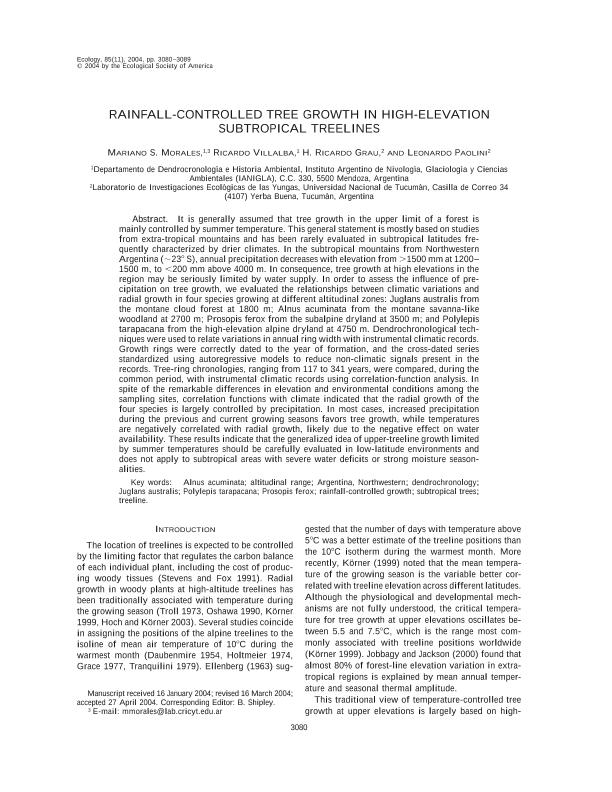Mostrar el registro sencillo del ítem
dc.contributor.author
Morales, Mariano Santos

dc.contributor.author
Villalba, Ricardo

dc.contributor.author
Grau, Hector Ricardo

dc.contributor.author
Paolini, Leonardo

dc.date.available
2020-04-07T21:19:25Z
dc.date.issued
2004-11
dc.identifier.citation
Morales, Mariano Santos; Villalba, Ricardo; Grau, Hector Ricardo; Paolini, Leonardo; Rainfall-controlled tree growth in high-elevation subtropical treelines; Ecological Society of America; Ecology; 85; 11; 11-2004; 3080-3089
dc.identifier.issn
0012-9658
dc.identifier.uri
http://hdl.handle.net/11336/102234
dc.description.abstract
It is generally assumed that tree growth in the upper limit of a forest is mainly controlled by summer temperature. This general statement is mostly based on studies from extra-tropical mountains and has been rarely evaluated in subtropical latitudes frequently characterized by drier climates. In the subtropical mountains from Northwestern Argentina (;238 S), annual precipitation decreases with elevation from .1500 mm at 1200? 1500 m, to ,200 mm above 4000 m. In consequence, tree growth at high elevations in the region may be seriously limited by water supply. In order to assess the influence of precipitation on tree growth, we evaluated the relationships between climatic variations and radial growth in four species growing at different altitudinal zones: Juglans australis from the montane cloud forest at 1800 m; Alnus acuminata from the montane savanna-like woodland at 2700 m; Prosopis ferox from the subalpine dryland at 3500 m; and Polylepis tarapacana from the high-elevation alpine dryland at 4750 m. Dendrochronological techniques were used to relate variations in annual ring width with instrumental climatic records. Growth rings were correctly dated to the year of formation, and the cross-dated series standardized using autoregressive models to reduce non-climatic signals present in the records. Tree-ring chronologies, ranging from 117 to 341 years, were compared, during thecommon period, with instrumental climatic records using correlation-function analysis. In spite of the remarkable differences in elevation and environmental conditions among the sampling sites, correlation functions with climate indicated that the radial growth of the four species is largely controlled by precipitation. In most cases, increased precipitation during the previous and current growing seasons favors tree growth, while temperatures are negatively correlated with radial growth, likely due to the negative effect on water availability. These results indicate that the generalized idea of upper-treeline growth limited by summer temperatures should be carefully evaluated in low-latitude environments and does not apply to subtropical areas with severe water deficits or strong moisture seasonalities.
dc.format
application/pdf
dc.language.iso
eng
dc.publisher
Ecological Society of America

dc.rights
info:eu-repo/semantics/openAccess
dc.rights.uri
https://creativecommons.org/licenses/by-nc-sa/2.5/ar/
dc.subject.classification
Ecología

dc.subject.classification
Ciencias Biológicas

dc.subject.classification
CIENCIAS NATURALES Y EXACTAS

dc.title
Rainfall-controlled tree growth in high-elevation subtropical treelines
dc.type
info:eu-repo/semantics/article
dc.type
info:ar-repo/semantics/artículo
dc.type
info:eu-repo/semantics/publishedVersion
dc.date.updated
2020-03-30T14:34:32Z
dc.journal.volume
85
dc.journal.number
11
dc.journal.pagination
3080-3089
dc.journal.pais
Estados Unidos

dc.description.fil
Fil: Morales, Mariano Santos. Consejo Nacional de Investigaciones Científicas y Técnicas. Centro Científico Tecnológico Conicet - Mendoza. Instituto Argentino de Nivología, Glaciología y Ciencias Ambientales. Provincia de Mendoza. Instituto Argentino de Nivología, Glaciología y Ciencias Ambientales. Universidad Nacional de Cuyo. Instituto Argentino de Nivología, Glaciología y Ciencias Ambientales; Argentina
dc.description.fil
Fil: Villalba, Ricardo. Consejo Nacional de Investigaciones Científicas y Técnicas. Centro Científico Tecnológico Conicet - Mendoza. Instituto Argentino de Nivología, Glaciología y Ciencias Ambientales. Provincia de Mendoza. Instituto Argentino de Nivología, Glaciología y Ciencias Ambientales. Universidad Nacional de Cuyo. Instituto Argentino de Nivología, Glaciología y Ciencias Ambientales; Argentina
dc.description.fil
Fil: Grau, Hector Ricardo. Universidad Nacional de Tucumán. Facultad de Ciencias Naturales e Instituto Miguel Lillo. Laboratorio de Investigaciones Ecológicas de las Yungas; Argentina. Consejo Nacional de Investigaciones Científicas y Técnicas. Centro Científico Tecnológico Conicet - Tucumán; Argentina
dc.description.fil
Fil: Paolini, Leonardo. Universidad Nacional de Tucumán. Facultad de Ciencias Naturales e Instituto Miguel Lillo. Laboratorio de Investigaciones Ecológicas de las Yungas; Argentina. Consejo Nacional de Investigaciones Científicas y Técnicas. Centro Científico Tecnológico Conicet - Tucumán; Argentina
dc.journal.title
Ecology

dc.relation.alternativeid
info:eu-repo/semantics/altIdentifier/url/https://esajournals.onlinelibrary.wiley.com/doi/abs/10.1890/04-0139
dc.relation.alternativeid
info:eu-repo/semantics/altIdentifier/doi/https://doi.org/10.1890/04-0139
Archivos asociados
